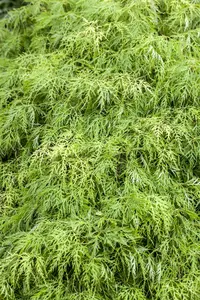Aesculus hippocastanum 'Pyramidalis' - STD 10-12 CM CONT
Aesculus hippocastanum 'Pyramidalis' - STD 10-12 CM CONT
Description
The Horse chestnut 'Pyramidalis' (Aesculus hippocastanum) is a broad, pyramidal small tree that produces white flowers arranged in panicles. They appear in May. These produce dark brown fruits from October. The Horse chestnut 'Pyramidalis' also has palmate, dark green leaves. Its bark is dark grey and scaly. In a sunny to semi-shady location with well-drained, nutrient-rich soil, it usually reaches a height of around 8 metres and grows to a width of around 6 metres.
Bulletpoints
* the flowers are heavily favoured by bees, bumblebees and hoverflies
* attractive yellow autumn colouring
* resistant to urban climates, tolerates soil salts, can be planted over, stem protection recommended
Leaves
The deciduous leaves of Horse chestnut 'Pyramidalis' are dark green, palmate, opposite. They are about 10 - 20 cm tall. Horse chestnut 'Pyramidalis' turns bright yellow in autumn.
Bark
Dark grey, scaly bark makes this plant an eye-catcher in any garden.
Spread
Germany.
Frost hardiness
The Horse chestnut 'Pyramidalis' has good frost hardiness.
Growth
Broad, pyramidal.
Water
The plant has a medium water requirement.
Location
Preferred location in a sunny to semi-shady position.
Soil
Normal soil.
Planting time
Container plants can be planted all year round, except when the ground is frozen and in summer heat (over 30°C).
Care
Cut and saw wounds and broken branches should be treated as quickly as possible with a wound sealant to prevent pathogens from entering the plant.
Flower
The white flowers of Horse chestnut 'Pyramidalis' appear in panicles in May.
Interesting facts
Plant or parts of the plant are poisonous.
Use
Solitary, medicine, park, bee pasture, homeopathy
Root
Aesculus hippocastanum 'Pyramidalis' is a heartroot.
- Article number2
-
EAN codeAEHPYRAM-51012C
- Latin nameAesculus hippocastanum 'Pyramidalis'
- catalogLandscape shop



